I know I am not the only one puzzled by two seemingly contradictory properties that are claimed for Immortelle oil (Helichrysum italicum). Side note: you may know this as Helichrysum oil, but I am averse to co-opting a botanical name when there are several really quite attractive common names – Immortelle, Everlasting, Curry plant. Also, while there are several Helichrysum oils, there is only one Immortelle, so using “Immortelle” is less potentially confusing. But I digress. The properties in question are hemostatic and anticoagulant.
Hemostatic means “capable of causing bleeding to stop when it is applied to a wound.” Another word would be styptic. Hemostatic substances are used to stop bleeding. Anticoagulant means “having the effect of retarding or inhibiting the coagulation of the blood.” Anticoagulants (blood thinners) are given to people who are at high risk for blood clots.
So, one is about causing blood to clot, and the other is about preventing this from happening, and I cannot see how both are possible. Here are some quotes from the internet showing that both properties are being claimed for Immortelle oil:
Hemostatic
“Helichrysum oil is known to stop minor bleeding from wounds, cuts and even nose bleeds”
https://joyaessentials.com/products/helichrysum-organic
“Helichrysum can be used as an emergency first aid treatment of injuries. It can be applied drop by drop to bleeding wounds, even large ones, if medical help is not available.” https://www.mymagicalemporium.com/helichrysumoil.htm
“My friend Jeff was over the other day, and went to pop the top off of a beer bottle. He was using the wrong type of tool, and sliced deep into a finger, which started gushing blood immediately. We got him a towel to clean it and wipe up the blood, dropped a drop of Helichrysum on it, and that was the end of the bleeding.” http://www.oil-testimonials.com/essential-oils/4378/helichrysum-stops-bleeding-instantly-again
“In Traditional French Medical Aromatherapy, it is recommended to apply several drops of Helichrysum italicum directly onto the cut or wounded skin area.” https://nomadbotanicals.com/blogs/blog/helichrysum-essential-oil-uses-benefits
It’s not obvious where this idea of quickly stopping bleeding originated from. Possibly France (see last quote above) and possibly France via Kurt Schnaubelt, who says: “Helichrysum italicum is so mild that sometimes it is it is the preferred option for the immediate treatment of injuries, especially bleeding wounds.” (Schnaubelt 2011). I have never tried applying undiluted Immortelle oil to an open wound, but I suspect that it might sting like crazy – Lavender oil certainly does.
Anticoagulant
“…as an anticoagulant, helichrysum essential oil can be a blessing for those who run the risk of heart attacks due to the thickening of blood because of a high cholesterol content. It can immediately provide relief in such cases by liquefying or thinning the blood.” https://theoilyguru.org/2018/01/08/21-amazing-benefits-of-helichrysum-essential-oil/
The advice of the Aromatherapist, André Bitsas (Body and Soul Aromatherapy, Editions Amyris, p. 134): “…the essential oil of helichrysum thins the blood, is anticoagulant. It is remarkably effective on hematomas (“bruises”) even old and internal.” https://www.aroma-zen.com/en/immortelle-helichrysum-helichrysum-italicum-30ml-biological-bioflore-p-10492.html
“Helichrysum essential oil….acts as an anticoagulant and can prevent blood clotting in patients who are susceptible to thrombosis.” https://www.myrro.gr/en/essential-oils/1129-helichrysum-clear-essential-oil.html
“The essential oil of helichrysum helps clear the accumulation of blood or blood clots which result from a hemorrhage. This can be very helpful in clearing blood clots out of the brain after a brain hemorrhage.” https://www.organicfacts.net/health-benefits/essential-oils/health-benefits-of-helichrysum-essential-oil.html
The origin of this anticoagulant claim may be a French text, which lists the following properties for Immortelle oil: anticoagulant, antiphlebitis, antihematoma (Franchomme & Penoel 1990, p356).
Which of these claims is true? First, let’s take a look at the mechanisms involved in both processes.
Blood coagulation
“Blood clotting, or coagulation, is an important process that prevents excessive bleeding when a blood vessel is injured. Platelets (a type of blood cell) and proteins in your plasma (the liquid part of blood) work together to stop the bleeding by forming a clot over the injury.” https://www.hematology.org/education/patients/blood-clots
The series of events leading up to platelets sticking together in a wound is complex, and involves a number of cells and substances, but the important fact here is that this process causes a blood clot to form, which is vital in the initial stages of wound healing. It helps prevent further blood loss by patching up the wound, as if with a fine mesh. When blood clots form inside an artery this is potentially dangerous, as a free-floating clot could interfere with either blood flow through the heart, or the supply of oxygen to part of the brain. But for wound healing, coagulation is a vital first step.
Platelets have a number of useful properties, but they are absolutely central to blood clotting, and their change in behavior (from free-floating through our blood vessels) is known as platelet aggregation and adhesion.
Blood thinning
The action of inhibiting platelet aggregation is sometimes known as “antiaggregation”, but we would commonly refer to it as “blood thinning”, though the blood is not actually thinned at all. Anticoagulant drugs may be taken when a person’s blood is threatening to form dangerous, free-floating clots.
Warfarin (coumadin) is perhaps the most well-known anticoagulant, and it works by slowing down the body’s process of creating clots. (Note that many anticoagulants are derivatives of coumarin, but coumarin itself, found in Cassia and Lavender oils, is not blood thinning.) Aspirin, another anticoagulant, works by preventing platelets from sticking together.
Now that we know the basics of the processes involved, let’s see what the evidence tells us for Immortelle oil.
β-Diketones as anticoagulants
Immortelle essential oil derives from Helichrysum italicum, and it has some unusual constituents, including compounds called italidiones. There are several of these, and they are typically present at a total of 5-10% of the essential oil, but the extremes are 0-20%. Italidiones are classed as β-diketones, which means that there are two ketone functional groups separated by a singe carbon atom. This is interesting because some other β-diketones demonstrate anticoagulant properties. For example, rat poisons (rodenticides) often contain derivatives of 1,3-indandione (which is not found in essential oils), and these derivatives are more potent than the parent compound (Chen et al 2019, Pluskota & Koba 2018).
1,3-Indandione has the β-diketone structure attached to a benzene ring as do, naturally, the widely-used derivatives found to be anticoagulant – chlorophanicone, diphacinone, pindone and valone – as well as other derivatives currently being researched. In contrast to this, the italidiones are open structures with no benzene ring, and I personally doubt that they would be as potent as rat poisons, as the benzene ring seems to be an important factor.
I could speculate further about whether the italidiones in Immortelle oil are similarly anticoagulant to the rodenticides, but the simple fact is, we do not know. Even if they are, we do not know how potent any of them might be. We just don’t know, and there is no scientific evidence that Immortelle oil is anticoagulant, though there is one compelling anecdote, from aromatherapist Robin Schiller-Kessler:
“Helichrysum oil does thin the blood. I am on blood thinners and I was using Helichrysum italicum oil at 2% in fractionated coconut oil for one week to try to get rid of an old bruise that left a scar. I go weekly for an INR . My levels need to be between 3.0 and 3.5. The test showed 5.0. The only thing I was using was that oil 2 x a day. I stopped it, I had to stop taking my Warfarin for 2 days so the level went down and I had to go back to be tested in a week. They did go down and re-stabilized. Again, the only thing I did different was to take this oil, I have been on blood thinners for 15 years so I normally know what makes my blood go up and down. After this I did some research on my own and found others who were on blood thinners and had a similar problem with this oil.”
It is very useful that here the effect is backed up by objective INR readings, but we would need to see this effect replicated to be able to make any reliable conclusions.
There is even less supportive information for Immortelle oil being hemostatic. In fact I have not been able to find published information on any essential oil, or constituent, demonstrating hemostatic properties.
Based on what we found so far, we have at least some evidence for an anticoagulant effect, and no evidence to the contrary. What we’re going to look at next may help explain the hemostatic claims, and may also show the importance of using the correct terminology.
Wound healing
There is one related aspect that has been researched. Immortelle oil has documented antibacterial and anti-inflammatory effects which suggest good activity in wound healing (Djihane et al 2017, Gencic et al 2021), and this has been tested experimentally in rats. Excision wounds in diabetic rats were treated for 21 days with (A) nothing, (B) an ointment base, (C) a standard treatment (1% silver sulfadiazine), or (D) the ointment base with 0.5% w/w Immortelle oil. Results, measured as degree of wound contraction, were: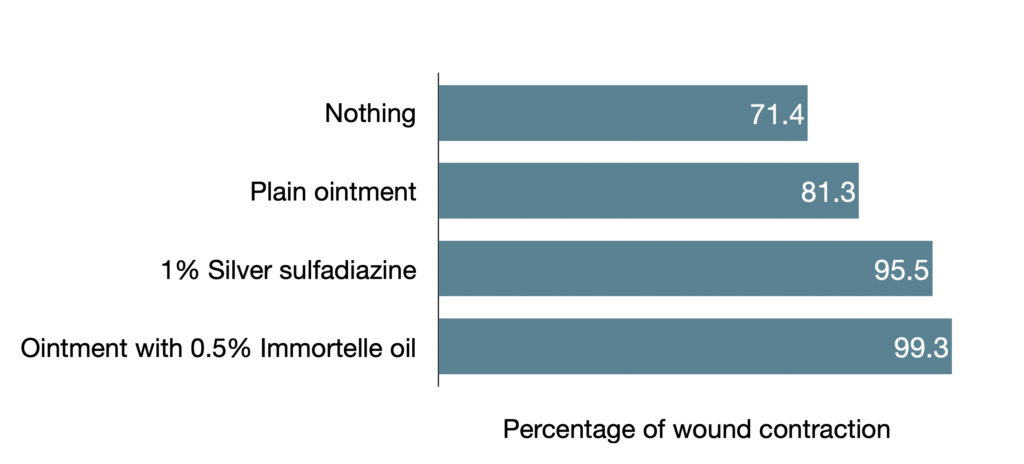
The results of this study imply that 0.5% Immortelle oil in an ointment base could be just as effective for wound healing as a standard treatment. In addition, group D showed good scar maturation, and increased density of both collagen I – the most important form of collagen – and collagen fibers. It’s also worth noting that 0.5% essential oil is an impressively low concentration for wound healing, 5% being common, and sometimes more is used for infected wounds.
Collagen is important both in wound healing and in skin firmness and plumpness. In other research, Immortelle oil was found to inhibit collagenase, the enzyme that breaks down collagen, which supports the idea that Immortelle oil may be helpful in anti-aging products as well as wound healing (Fraternale et al 2019). Frankincense oil, incidentally, had no effect on collagen I levels in an in vitro test, and actually depleted collagen III levels (Han et al 2017). So, forget Frankincense for anti-aging, use Immortelle! But please don’t use it undiluted – it will not do good things to your skin if you do.
It could be that Immortelle’s wound healing properties got misconstrued as being due to increased blood clotting, which, however, is only one part of the whole process.
Summing up
So, this is what we’re left with. There are claims for Immortelle oil being both hemostatic and anticoagulant. These are contradictory actions, so they cannot both be true, but when we look at the evidence, there is very little. It’s not likely that Immortelle oil is hemostatic since no other essential oils are, though it may still be useful in wound healing, which is a complex process involving more than coagulation. The oil could well be anticoagulant, as this property is seen in a few essential oils and constituents.
However, apart from one anecdotal report, all we are left with is the tenuous implication that because certain other, similar compounds are potent anticoagulants, maybe italidiones are too, and maybe their effect is powerful enough to also manifest in the essential oil. It’s completely possible, perhaps even likely, that Immortelle oil is in fact anticoagulant, and it’s also possible that, even if it is, this might have nothing to do with its content of italidiones! Whatever effect Immortelle oil may have on blood coagulation, there is some evidence that it can help in wound healing.
Have you had an experience with Immortelle oil that addresses the content of this article? If so, please comment below.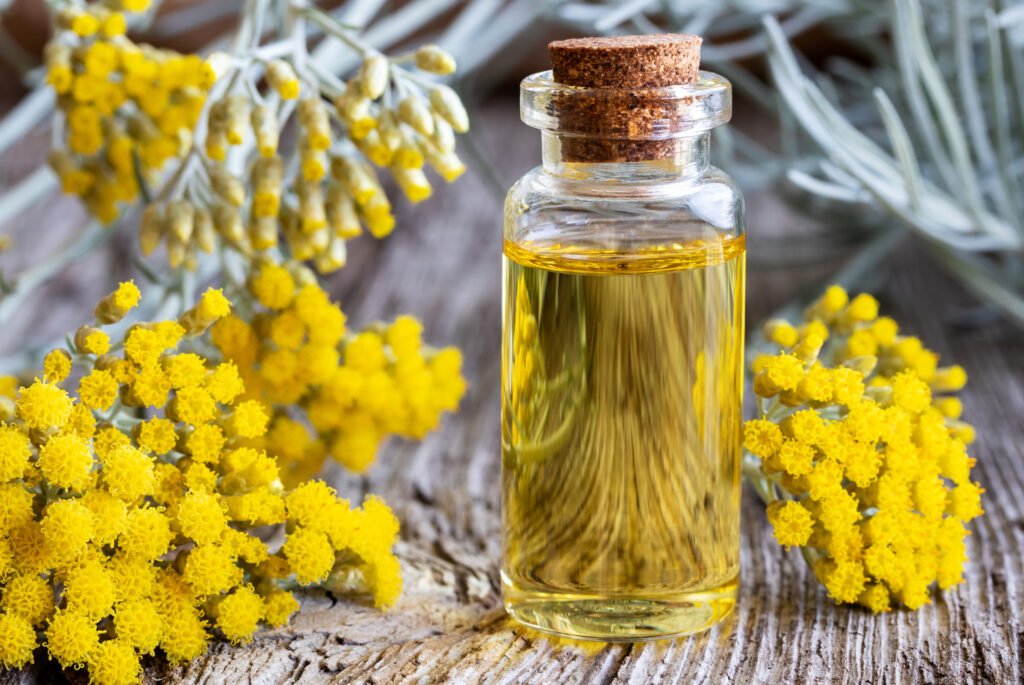
References
Andjić, M., Draginić, N., Kočović, A. et al (2022). Immortelle essential oil-based ointment improves wound healing in a diabetic rat model. Biomedicine and Pharmacotherapy, 150(April). https://doi.org/10.1016/j.biopha.2022.112941
Chen, F., Zhang, T., Qu, C. et al (2019). The research of synthesis and bioactivity of the novel indanedione anticoagulant rodenticides. Environmental Science and Pollution Research, 26(14), 13833–13838. https://doi.org/10.1007/s11356-018-3539-0
Djihane, B., Wafa, N., Elkhamssa, S. et al (2017). Chemical constituents of Helichrysum italicum (Roth) G. Don essential oil and their antimicrobial activity against Gram-positive and Gram-negative bacteria, filamentous fungi and Candida albicans. Saudi Pharmaceutical Journal, 25(5), 780–787. https://doi.org/10.1016/j.jsps.2016.11.001
Franchomme & Pénöel (1990) L’Aromathérapie exactement. Limoges, Roger Jollois
Fraternale, D., Flamini, G., & Ascrizzi, R. (2019). In vitro anticollagenase and antielastase activities of essential oil of Helichrysum italicum subsp. italicum (Roth) G. Don. Journal of Medicinal Food, 22(10), 1041–1046. https://doi.org/10.1089/jmf.2019.0054
Genčić, M. S., Aksić, J. M., Živković Stošić, M. Z. et al (2021). Linking the antimicrobial and anti-inflammatory effects of immortelle essential oil with its chemical composition – The interplay between the major and minor constituents. Food and Chemical Toxicology, 158(September). https://doi.org/10.1016/j.fct.2021.112666
Han, X., Rodriguez, D., & Parker, T. L. (2017). Biological activity of frankincense essential oil in human dermal fibroblasts. Biochimie Open, 4, 31–35. https://doi.org/10.1080/2331205X.2017.1298176
Pluskota, R. & Koba, M. (2018). Indandione and its derivatives – chemical compounds with high biological potential. Mini Reviews in Medicinal Chemistry 18(15). doi: 10.2174/1389557518666180330101809
Schnaubelt, K. (2011). The healing intelligence of essential oils. Healing Arts Press, Rochester.

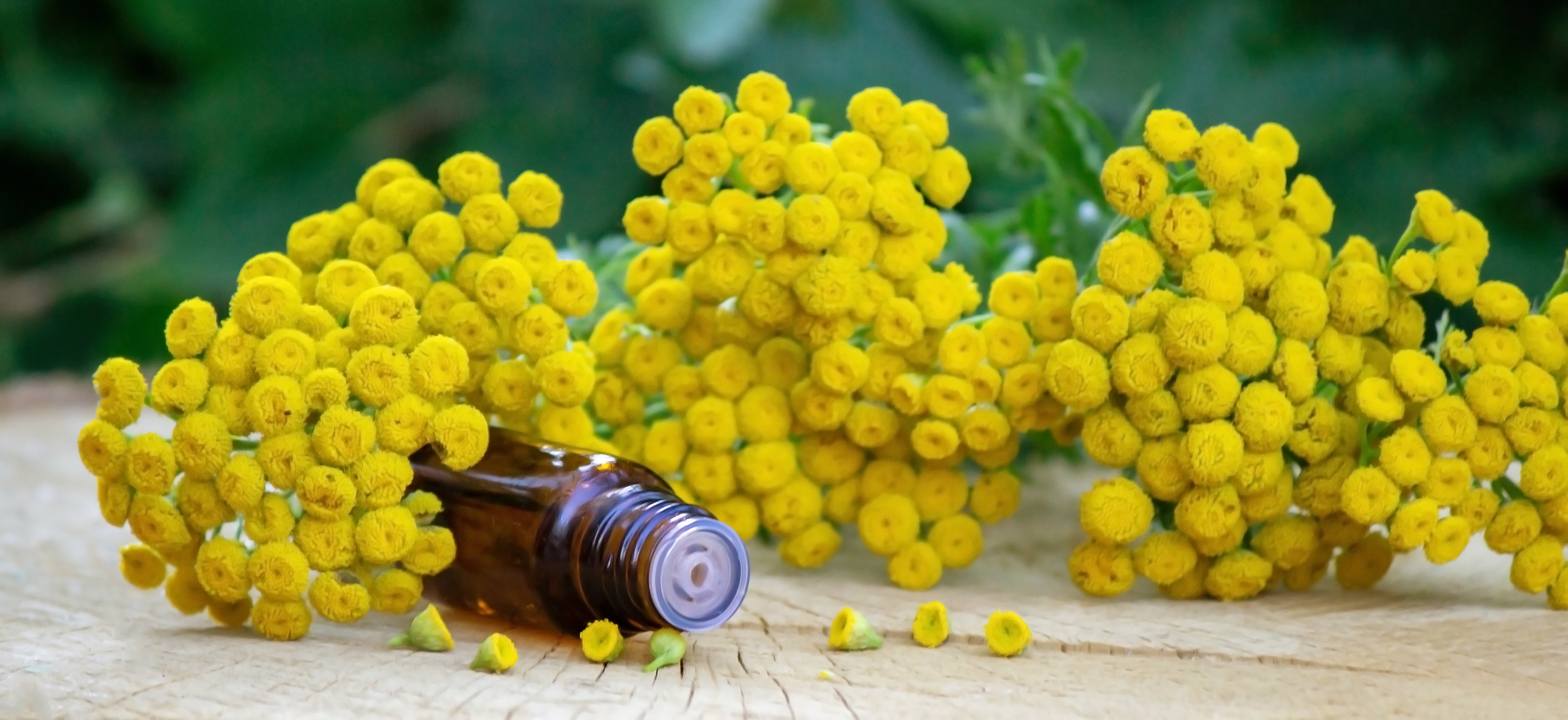
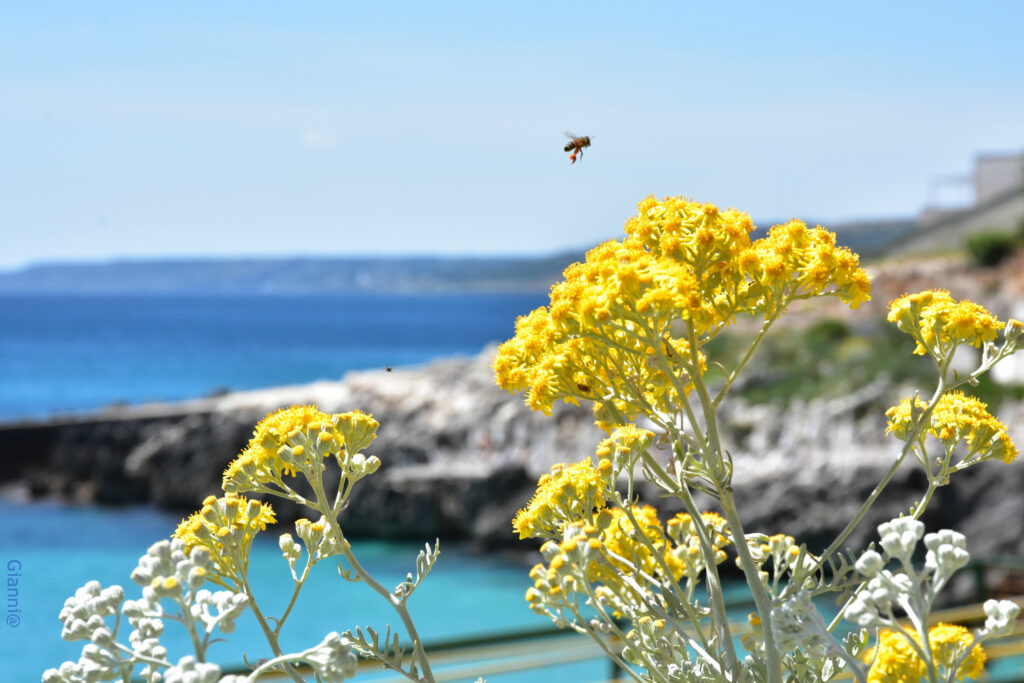
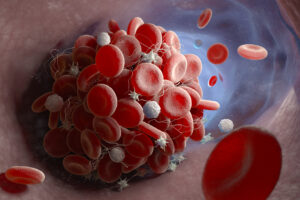
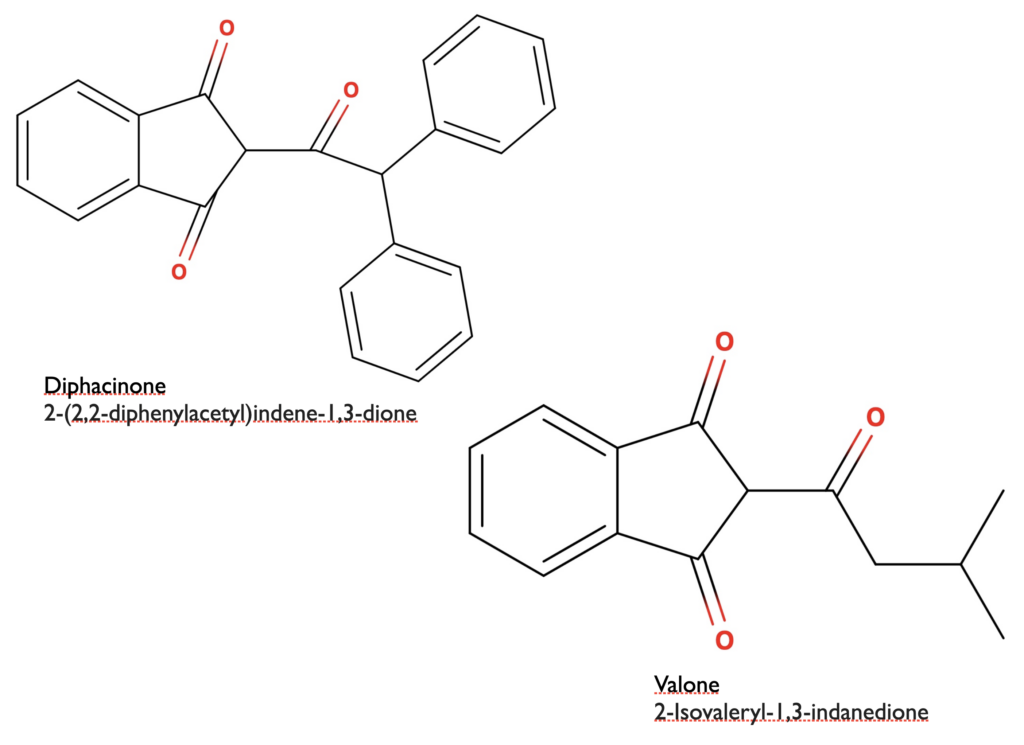
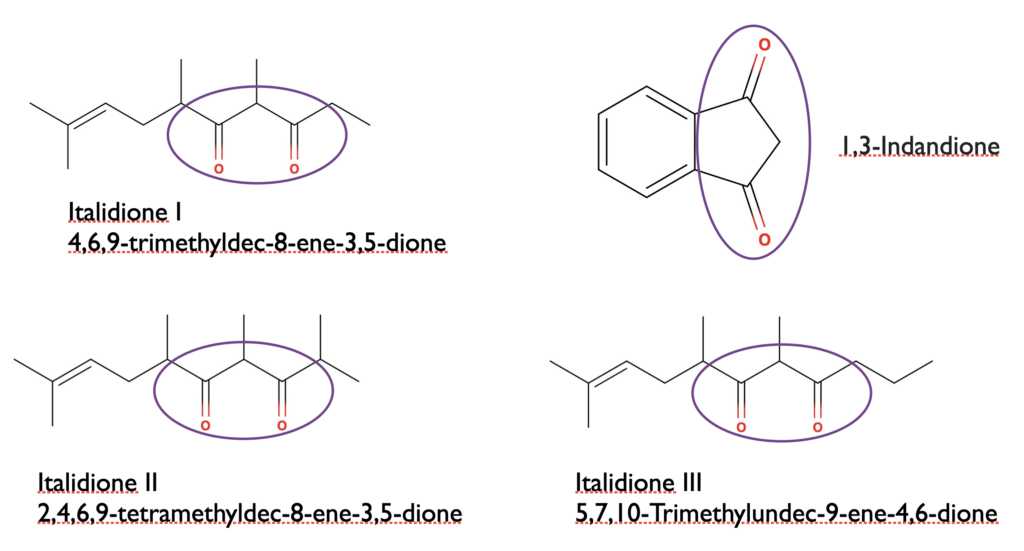
0 Comments